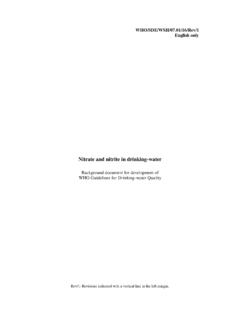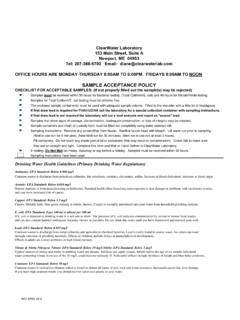Transcription of Interpreting Drinking Water Test Results
1 G3558-4. HOME Water SAFETY. Interpreting Drinking Water Test Results by Chris Mechenich and Elaine Andrews M. usty odors, red-brown stains on plumbing fixtures, bathtub This fact sheet is part of a series rings all these are unpleasant signs of Water quality designed to help you determine problems, but usually not of harmful contaminants in the the quality of your home Drinking Water and to show you techniques Water . Contaminants that may threaten our health are usually not available for improving it. To make discernible by the senses. Drinking Water can contain nitrate, the best use of these publications, bacteria, and pesticides at levels which cannot be tasted or smelled, include them in a household file but which can be hazardous to health. containing well information and Water test Results . If your Drinking Water comes from a private well, you should test your Water once a year even if you do not observe any smells, stains Other fact sheets in the series are: or changes in Water quality.
2 Only analysis by a certified laboratory Keeping Your Home Water can determine if the Water is free of harmful contaminants. This Supply Safe (G3558-1) publication provides information about how to interpret the Evaluating the Condition of laboratory Results for a basic set of tests conducted as part of the Your Private Water Supply University of Wisconsin Extension Water testing program and that (G3558-2) are recommended for all private wells. Evaluating the Condition of The tests described in this publication are also conducted on public Your Public Water Supply Water supplies. If you are using Water from a public Water utility, (G3558-3). consider having the Water tested if your home plumbing system Choosing a Water contains lead or copper pipes or lead solder, if you are installing a Treatment Device (G3558-5) Water treatment device, or if you have concerns about the Water . See The Extension bulletin Maintaining Evaluating the Condition of Your Public Water Supply (G3558-3), for Your Home Well Water System more information.
3 (G3399), can be used with these publications. The Initial Set of Water tests This series was developed by the Anyone buying a home with a private well, installing a new well or University of Wisconsin simply having their well Water tested for the first time should run Cooperative Extension in cooperation with the Wisconsin the basic set of tests described here. These tests give a good overall Department of Natural Resources picture of current Water quality, indicate possible problems, and and the Wisconsin Department of provide a baseline for comparing future test Results . Each test is Commerce. described in more detail in this publication. Always have a certified laboratory conduct the tests . Labs certified by the Department of Natural Resources or Department of Agriculture, Trade and Consumer Protection must meet standards for accuracy. A. list of certified labs is available from county Extension offices and Department of Natural Resources (DNR) regional offices.
4 tests to Identify Contaminants that Harm Health WHAT IS A PART. PER MILLION? BACTERIA. Bacteria, viruses and parasites in Water can cause disease. The coliform bacteria test indicates the possible presence of disease- Laboratory equipment can causing bacteria from human or animal waste. measure contaminants in Water at extremely low levels, such as NITRATE. A form of nitrogen that can dangerously reduce the parts per million (ppm) or even amount of oxygen in the blood of infants under six months old and parts per billion (ppb). For may also harm the unborn. Nitrate is a common contaminant from example, one part per million fertilizers, septic systems and animal wastes. It often indicates the can be imagined as one red marble mixed in with 999,999 presence of other contaminants. blue marbles, one inch in sixteen LEAD AND COPPER. Lead and copper can be leached into Water from miles, or a minute in the space of pipes or solder and can represent a significant health threat.
5 Two years. One part per billion is the same as two croutons in a tests to Determine Overall Water Quality five hundred pound salad, or eight drops of Water in an Olympic- ALKALINITY. Measurement needed to determine corrosivity. sized swimming Although such small numbers may seem CHLORIDE. High concentrations often indicate contamination from quite insignificant, even one part a septic system, fertilizer, landfill or road salt. per billion or less of certain CONDUCTIVITY. Measures the ability of Water to conduct an chemicals has been found to cause adverse health effects. electrical current; can be used to signal the presence of contaminants. 1 These creative part-per-million and part- per-billion examples are from the CORROSIVITY INDEX. A combination of several tests that indicates WaterTest Corporation, New London, NH. the tendency for Water to corrode plumbing, or for lime deposits to form in pipes. HARDNESS. Helps determine the need for Water softening; also influences corrosivity.
6 PH. Indicates Water 's acidity and helps determine if Water will corrode plumbing. After running the initial set of tests , well users should continue to test for bacteria once a year. It's also a good idea to test for nitrate annually for several years. If nitrate levels are consistently low, nitrate tests are not necessary every year. However, a nitrate test should always be conducted if an infant or pregnant woman is Drinking the Water . A Note on Drinking Water Standards Public Water supplies must meet numerical Water quality standards set by the United States Environmental Protection Agency and enforced by the Wisconsin DNR. Routine testing is not required for private wells. However, users of private well Water should at least be aware of the broad range of contaminants that may be found in well Water and that concern public health officials. Primary standards provide health limits for 82 contaminants as of list includes 8 inorganic compounds, such as arsenic, copper and lead; pesticides, such as aldicarb and chlordane; volatile organic chemicals such as benzene and trichloroethylene; PCBs.
7 2. microbial pathogens; and radioactive elements. Secondary standards provide aesthetic limits for 13 contaminants, such as iron, zinc, color and odor. The sources and maximum contaminant levels (MCL) for these substances are described in the publication Private Drinking Water Supplies: Quality, Testing and Options for Problem Waters listed in the resource section of this fact sheet. Testing private well Water supplies for all these contaminants would be expensive and is not recommended unless your well is close to a known or suspected source of contamination. The Initial Water tests : What the Results Mean The initial set of Water tests can provide a good overview of your well Water quality if you know how to interpret the Results . The information below provides a starting point for evaluating your Water quality. Note that Water test Results are usually presented in milligrams per liter (mg/L) or micrograms per liter ( g/L). For example, a Water test might indicate that the Water contains 6 mg/L nitrate, meaning that a liter of Water contains an average concentration of 6 milligrams of nitrate.
8 Note also that one mg/L is equivalent to one part per million (ppm). One g/L equals one part per billion (ppb). Coliform Bacteria Coliform bacteria are microorganisms found in surface Water , soil and in the feces of humans and animals. They do not usually cause disease. However, their presence indicates that fecal wastes may be contaminating the Water and means that pathogenic (disease- causing) organisms could be present. If human or animal wastes are contaminating the Water , gastrointestinal diseases, hepatitis or other diseases may result. Many labs can also test for a specific fecal coliform bacteria, E. coli. The presence of E. coli in a Water sample represents an even greater health risk than the presence of total coliform bacteria. Not present Present Safe Unsafe ACCEPTABLE Results : 0 coliform/100 milliliters (ml) of Water . If you have coliform bacteria present, you should resample. If a second test shows coliform, take corrective action.
9 3. CORRECTIVE ACTIONS: Coliform bacteria in groundwater indicate that contaminated surface Water is entering groundwater without the filtering effect that soils usually provide. In areas where the bedrock is fractured and close to the surface, or in areas with coarse sand and gravel soils, contaminated surface Water can naturally find its way into the groundwater. More often, detection of coliform bacteria in well Water is an indication that contaminated surface Water is entering a well because of defects in well construction or maintenance. If coliform bacteria are detected in the Water sample, have another sample tested. Carefully follow the sampling steps suggested by the laboratory to ensure that your sampling procedure itself is not contaminating the Water . If the second test shows bacterial contamination, check the well for defects. Some defects are easily viewed; others might require excavating around the well. Follow this checklist as you look for obvious defects: Is the cap or seal on tightly?
10 Is the well vented? The well cap should fit tightly to keep out surface Water and vermin. On a drilled well, the screened vent that allows air to enter the well must be securely connected to the cap or seal. Is all wiring in conduit (tubing that connects the well with the electrical box)? Is the casing at least 12 inches above the ground? (The casing is the steel or plastic pipe installed in the bore hole during construction.) Also, if there are visible holes or cracks in the casing, or if you can move it, there might be a problem. Is the well in a pit or basement? If so, it may not meet state requirements and might be unsafe. After correcting visible defects, disinfect the well with chlorine bleach and have another sample tested after all traces of chlorine have dissipated. Test again one month later to ensure that the contamination source has been eliminated. See the DNR. publication Bacteriological Contamination of Drinking Water and the Extension publication Evaluating the Condition of Your Private Water Supply (G3558-2) for more information.










